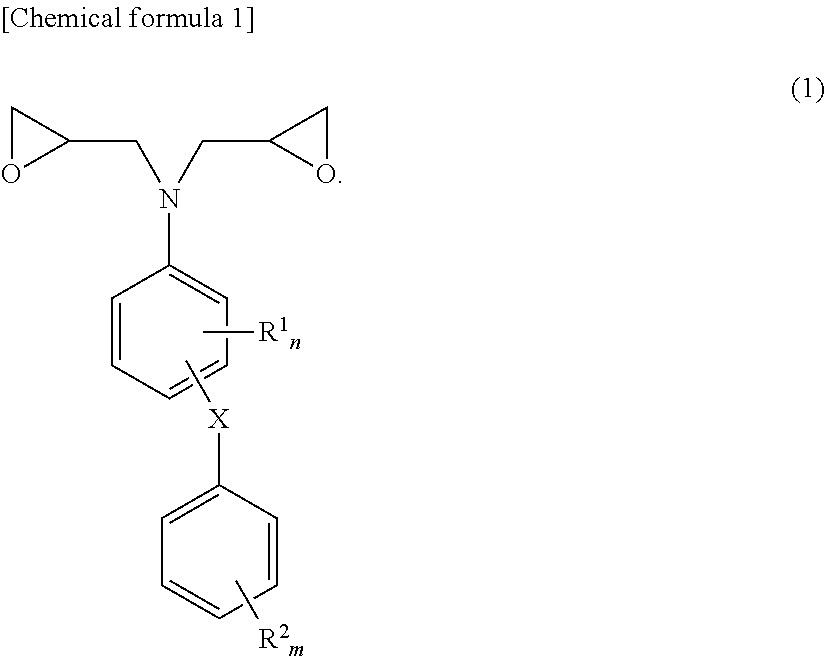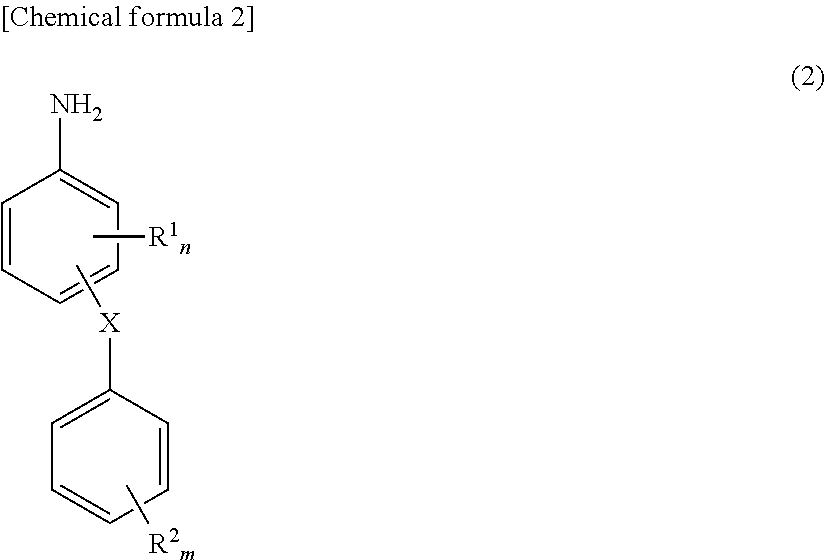Epoxy resin composition for fiber-reinforced composite material, prepreg, and fiber-reinforced composite material
a technology of epoxy resin and fiber reinforcement, applied in the direction of synthetic resin layered products, ceramic layered products, transportation and packaging, etc., can solve the problems of reducing other characteristics, hardly improving impact resistance, and fiber-direction compressive strength, and achieves excellent heat resistance and strength characteristics, small variation in characteristics, and high reliability
- Summary
- Abstract
- Description
- Claims
- Application Information
AI Technical Summary
Benefits of technology
Problems solved by technology
Method used
Image
Examples
working examples
[0234]The first preferred embodiment of the present invention relating to an epoxy resin composition is now described in more detail by way of a working example. The resin ingredient preparation methods and evaluation methods used in the working example are shown below.
[0235]Amine-type Epoxy Resin [A][0236](Difunctional-Type Epoxy Resin)[0237]N,N-diglycidyl-4-phenoxy aniline synthesized using the method described below
[0238]After placing 610.6 g (6.6 mol) of epichlorohydrin in a four-necked flask fitted with a thermometer, dropping funnel, cooling pipe and stirrer, the temperature was raised to 70° C. while performing a nitrogen purge, and 203.7 g (1.1 mol) of p-phenoxy aniline, dissolved into 1020 g of ethanol, was dropped over four hours. It was stirred for a further six hours to complete the addition reaction, and 4-phenoxy-N,N-bis(2-hydroxy-3-chloropropyl)aniline resulted. After lowering the temperature inside the flask to 25° C., 229 g (2.75 mol) of a 48% aqueous solution of Na...
working example 1
[0265]After kneading 20 parts by weight of N,N-diglycidyl-4-phenoxy aniline (difunctional amine-type epoxy resin [A]), 70 parts by weight of ELM434 (polyfunctional amine-type epoxy resin [A]), 10 parts by weight of EPON825 (epoxy resin other than [A]) and 7 parts by weight of SM4032XM10 (block copolymer [C] having reactive group capable of reacting with epoxy resin) in a piece of kneading equipment, 45 parts by weight of Seikacure-S, which is an aromatic amine curing agent [B] was kneaded to prepare an epoxy resin composition. Table 1 shows the composition and blending ratio (All figures shown in Table 1 are in parts by weight.). The epoxy resin composition obtained was subjected to the measurement of the bending modulus of elasticity, KIC, glass transition temperature, phase separation structure size and variation in phase separation structure size according to molding conditions, all with regard to a hardened resin material, in accordance with the procedures described in (2) Measu...
working example 13
[0316]After kneading 20 parts by weight of N,N-diglycidyl-4-phenoxy aniline (epoxy resin [A′]), 80 parts by weight of ELM434 (epoxy resin [B′]) and 8 parts by weight of “Kane Ace (registered trademark)” MX-416 in a piece of kneading equipment, 50 parts by weight of Seikacure-S (curing agent [C′]) was kneaded to prepare an epoxy resin composition for fiber-reinforced composite materials. Table 3 shows the composition and blending ratio (All figures shown in Table 3 are in parts by weight.). The epoxy resin composition obtained was subjected to the measurement of the bending modulus of elasticity and KIC, both with regard to a hardened resin material, in accordance with the procedures described in (2) Measurement of bending modulus of elasticity of hardened resin material and (3) Measurement of toughness (KIC) of hardened resin material. A resin film was also prepared by coating pieces of release paper with the prepared epoxy resin composition at an areal density of 50 g / m2 using a kn...
PUM
| Property | Measurement | Unit |
|---|---|---|
| glass transition temperature | aaaaa | aaaaa |
| size | aaaaa | aaaaa |
| temperatures | aaaaa | aaaaa |
Abstract
Description
Claims
Application Information
 Login to View More
Login to View More - R&D
- Intellectual Property
- Life Sciences
- Materials
- Tech Scout
- Unparalleled Data Quality
- Higher Quality Content
- 60% Fewer Hallucinations
Browse by: Latest US Patents, China's latest patents, Technical Efficacy Thesaurus, Application Domain, Technology Topic, Popular Technical Reports.
© 2025 PatSnap. All rights reserved.Legal|Privacy policy|Modern Slavery Act Transparency Statement|Sitemap|About US| Contact US: help@patsnap.com



